To my regular audience, we'll get back to grocery coupon talk very soon. However, this is an issue that cannot be ignored, as it affects the perception of all coupon shoppers who use coupons in an ethical manner. Many readers across multiple, respected coupon sites and blogs contributed to this report, and I will try to acknowledge them all at the end.
Earlier this week, I posted an
article about Jaime Kirlew, one of the shoppers featured in TLC's new season of "Extreme Couponing." Jaime made a name for herself last year when she posted YouTube videos showing her shopping at Target and fraudulently using coupons for one product on another (coupons for Crest Whitestrips on Tide, coupons for Olay Body Wash on Secret deodorant, and so on.) When commercials for the new show began airing,
many members of well-read messageboards among the couponing community recognized Jaime from her YouTube videos and raised concerns about whether she would use coupons in a fraudulent manner on TLC's Extreme Couponing.
The first clue that something was amiss with Jaime's shopping trip was her grocery list:
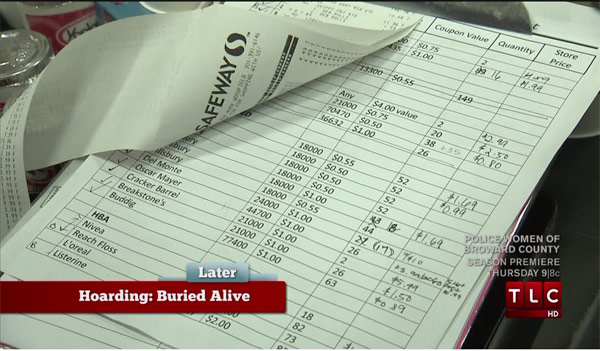 This list raised a lot of red flags with seasoned coupon shoppers because there are no products listed on it
This list raised a lot of red flags with seasoned coupon shoppers because there are no products listed on it. Instead, the list consists of manufacturers' names, and in the next column, a list of five-digit family codes -- a portion of a product's UPC bar code. The header row of that column appears to end in a "C" (UPC.)
Why would someone create a shopping list consisting only of product family codes, plus the coupon's dollar value that shares that family code?
Unfortunately, there's really only one logical answer to this question --
to use a coupon for one product on another, knowing that the register will "match" that coupon to a similar product.
Note that I do not teach UPC decoding as a method of matching coupons to sales -- it is not only highly unethical, but using the information obtained via decoding to intentionally then misuse a coupon to buy something other than what is specified is coupon fraud -- a crime. Without explaining exactly how it is done, there is a portion of a coupon's barcode that matches a portion of the product's barcode. This is how the register determines if the product has been purchased. Because of the way that the older barcode on a coupon matched that coupon to a product's family code, coupons for one General Mills product might scan without beeping on a different General Mills product. (And, don't get any "clever" ideas that decoding barcodes to use one coupon on a different item to get a better deal might be "smart shopping" -- it's fraud, plain and simple. This family-code coupon fraud exploit is being eliminated with an industry-wide update to the barcode system this year. Safeway stores' registers have now received the update, as have many others around the country.)
I'm going to post the evidence that many readers found over the past few hours. Please feel free to draw your own conclusions.
Looking at the video of her shopping trip from Wednesday night's premiere of Extreme Couponing on TLC, a reader posted three screen captures of the cereal Jaime purchased and the coupons she used to buy it:

The cereals that Jaime was shown buying in the episode were
Honey Nut Cheerios, Lucky Charms, and Kix, which were all part of a good sale the week of February 4th (if Safeway's ads are the same as our Dominick's, which they usually are, those 3 cereals were priced at $1.99 per box that week when Jaime shopped.)
However, the coupons that she appeared to use were for
.75 off Fiber One cereal.
As Fiber One is a more expensive cereal, General Mills typically issues higher-value coupons for Fiber One.
That .75 coupon doubled to $1.50, netting her .49 cereal. A great deal... IF the Fiber One had also been on sale too.
But it wasn't.
For the sake of argument,
let's assume that perhaps she also bought Fiber One cereal and it just wasn't shown on television.
In the next set of photos, we see Jaime's box of coupons for her trip. Note the
.50 coupons for Pillsbury French Bread and
$5-off-2 Nivea Body Lotion:
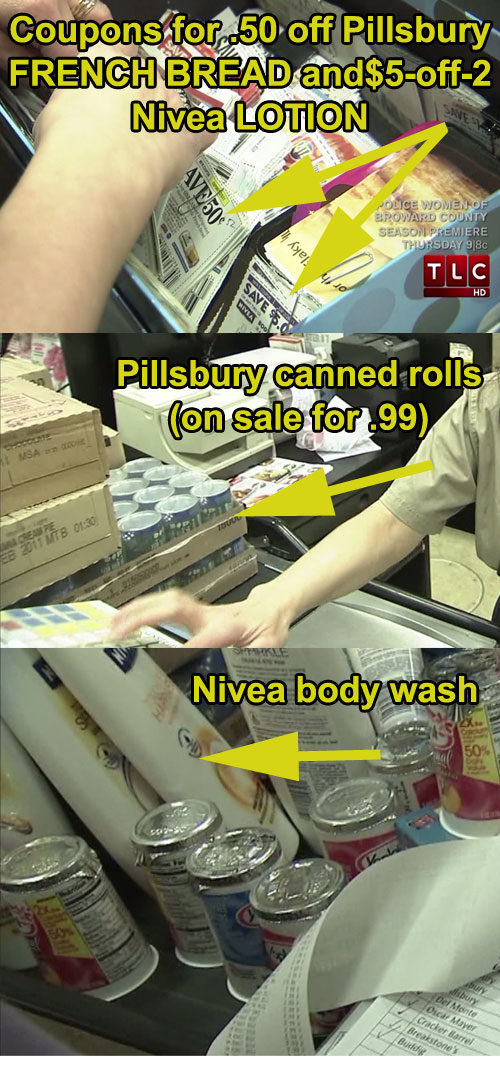
On the show,
we were not shown her buying any Pillsbury French Bread or Nivea Body Lotion. However, she did buy
.99 small cans of Pillsbury rolls and bottles of Nivea Body Wash.
With the small Pillsbury cans on sale for .99, the .50 Pillsbury French Bread coupons applied to them would double to $1,
making them free. The Nivea Body Lotion that the coupon is for typically sells for over $6/bottle. However, that week the Nivea Body Wash was much cheaper - $2.99 (again, if our Dominick's ad from that week is the same as Safeway's.) Using the $5-off-2 coupon made the body wash .49.
Great deals... IF the coupons had been for the right products.
But again, for the sake of argument,
let's assume that somewhere, she also bought Pillsbury French Bread and Nivea Body Lotion, even though we never saw those products purchased on the show.
In this photo, we see Jaime has a paper clip full of coupons for
.50 off 4-packs of Yoplait Yo-Plus yogurt:
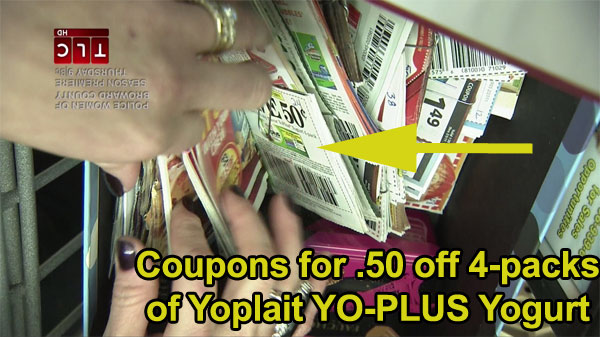
On the show, we were not shown Jaime buying any 4-packs of Yoplait Yo-Plus Yogurt.
But she did buy quite a few single cups of Yoplait Yogurt, which typically sell for around .33 per cup:
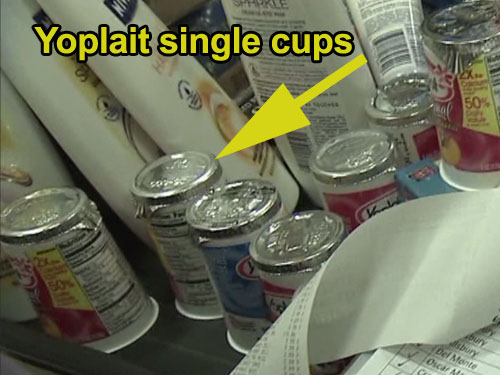
With a .50 Yo-Plus 4-pack coupon being applied to a .33 single cup of Yoplait, each cup is free with possible overage. But again...
it's coupon fraud to use the 4-pack coupon for an entirely different variety of Yoplait on the single cups.
So, again, for the sake of argument,
let's assume she also bought Yoplait Yo-Plus 4-packs, which viewers weren't shown in the segment.
In this photo, we see lots of packages of
Buddig Original lunchmeats in her cart:
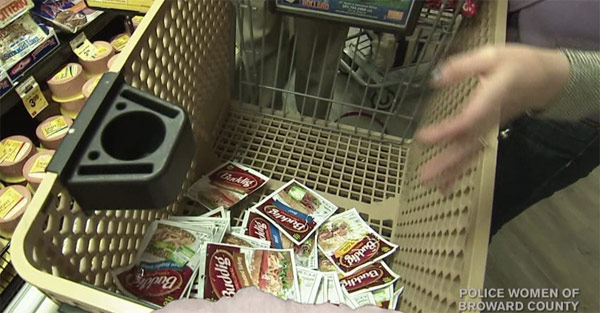
These 2-ounce packages of Buddig Original meats were on sale for .89 per package. On Jaime's spreadsheet shown at the top of this post, she notes that she will be buying 63 packages of Buddig, and she notes that she has $1 coupons for each of them with the UPC family code 77400.
Looking at a coupon database,
there were two current Buddig coupons in the inserts available during her February 4th, 2011 shopping trip. One coupon was a $1-off-4 2-ounce Buddig Original meats (again, the kind priced at .89 during this sale.)
The same coupon insert also contained a
$1-off-1 Buddig Deli Cuts coupon. Buddig Deli Cuts is a more expensive variety of lunchmeat that comes in a larger, 12-to-16-ounce package.
Again, back to the spreadsheet.
She planned to buy 63 Buddig lunchmeats priced at .89 each with 63 $1 coupons.
If she was using the $1-off-4 2-ounce packages of Buddig coupon (the correct coupon for this size product) she would have had to buy those lunchmeats in quantities of 4, again, as it is a $1-off-4 coupon. Couponers are notoriously good at math when it comes to figuring out trips!
It would make no sense to buy 63 of something that you needed to buy in quantities of 4, (you'd buy 64, an even number) unless...
She intended to use the
$1-off-1 12-to-16-ounce Buddig Deli Cuts coupon on the Buddig Original 2-ounce variety that were on sale for .89.
With a $1 coupon, they'd be free... but that would be fraud.
Which coupon did she appear to use for the Buddig Original 2-ounce lunchmeats?

The $1 coupons for
Buddig Deli Cuts, 12-to-16-ounces.
Here is a photograph of the coupon, oriented the correct way so that the size and product can be read:

Because this coupon shared the same family code as the smaller packages, it scanned
-- but the coupon is not for this product. It's for a different kind of Buddig that is also a larger size.
Why is this a big deal?
If the correct products were not purchased with the coupons used,
it's coupon fraud. Coupon fraud is a crime.
The terms of a coupon state "
CONSUMER: Redeem ONLY by purchasing the brand, size(s) and quantities indicated. ANY other use constitutes fraud."
- Using a Fiber One cereal on Cheerios is a crime.
- Using a Pillsbury French Bread coupon on Pillsbury rolls is a crime.
- Using a Nivea lotion coupon on Nivea Body Wash is a crime.
- Using a Buddig Deli Cuts coupon on Buddig Originals is a crime.
However, without seeing her receipt, and without seeing the entire contents of her trip on television, we do not know what else she may have purchased in this trip.
Unfortunately, there may be a few novice or non-coupon shoppers who, even when confronted with this, may think, "
So what? She got great deals!"
And, they're out there. When this story started to break yesterday, a fan on
Jaime's Facebook wall wrote,
"Gabby Paige - I don't even get why people are bothered by this??!! It does NOT affect YOU or any one else for that matter it doesn't take money or food out of any ones pocket whooooo carrrreessssss everything is so dam n expensive these days any way!"
Actually, this DOES affect all of us.
It affects the store because if the manufacturer wishes to audit the store for this transaction, and the manufacturer determines that the products that the correct products were not purchased with these coupons,
the manufacturer can refuse to reimburse the store for them. Then, Safeway will "eat" the cost of this shopping trip, because the terms of the coupon were not followed --
the specified items were not purchased, so they don't have to pay.
It affects new coupon shoppers whose interest is piqued by what they see on the show.
Seeing something on television validates it as "truth" for many people. If they see a "reality celebrity" using coupons in an "off-label" manner, for products that are
similar but not, as the manufacturer puts it, "ONLY ..the brand, size(s) and quantities indicated," they will assume this is acceptable -- or else, why would it be shown on television?
People assume that surely, the show must have an expert or professional on hand overseeing the kinds of trips that these shoppers are planning for the cameras, because thousands of viewers will want to duplicate what they see. Their other shows (My Strange Addiction, Hoarding) have a psychiatrist or therapist on board to protect and guide the people being depicted on the show, don't they?
This situation also affects anyone who isn't an "extreme couponer" but simply wishes to use coupons during a shopping trip.
What kind of scrutiny are people like you and me going to face at the register, when cashiers assume "those darn coupon shoppers" are trying to put one over on the store?
One bright spot in this story is something I touched on earlier -- as the industry transitions away from the old bar code to the new GS1 Databar (the "funny-looking" barcode on the right side of your coupons) it will eliminate this kind of fraud, as the new barcode is much more specific to the type of product that it can be used on. The new barcode system upgrade is in place at most stores now and has been rolling out around the country since this episode was filmed. DO NOT try to defraud the system by decoding barcodes.
The evidence is the video is difficult to refute. It looks like coupon fraud was committed on television, in prime time, as a ratings-grabber.
Coupon fraud IS a crime.
If the manufacturers refuse to reimburse Safeway for these coupons, Safeway will take a loss somewhere in the range of $1,800. Jaime's pre-coupon total was over $1,900 on the show, which she couponed down to about the $100 mark.
How is that any different than shoplifting $1,800 worth of groceries from Safeway?
The answer: It isn't.
And "Extreme Shoplifting" isn't what this show should be about.






























